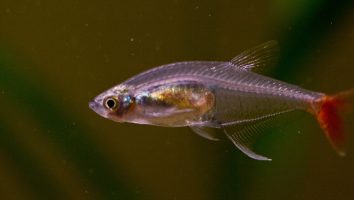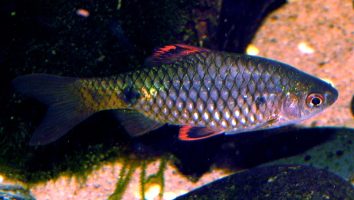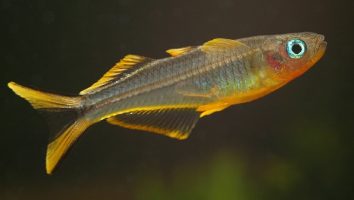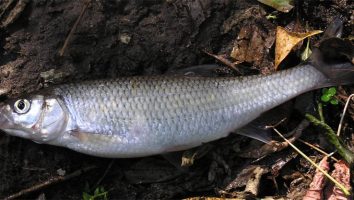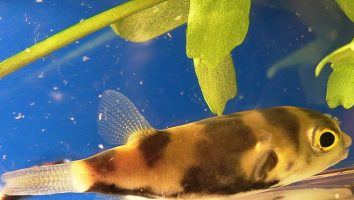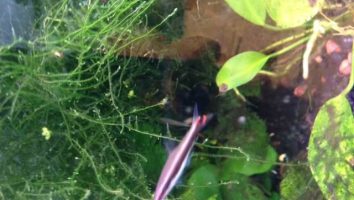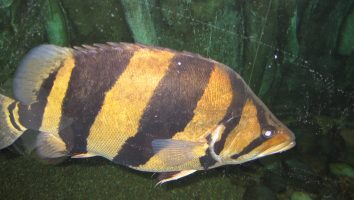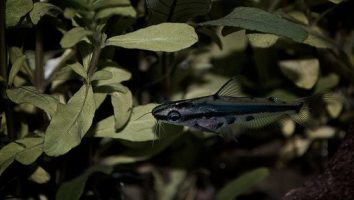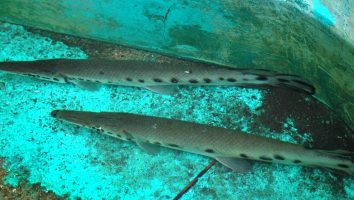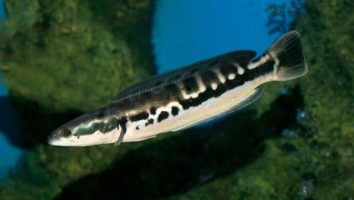The moonlight gourami is a beautiful and unique freshwater fish that is perfect for beginner aquarists.
This species is very peaceful, easy to care for, and can be kept in a wide range of tank sizes.
Moonlight gouramis are also very easy to breed, which is another reason why they are such a popular choice for beginner fishkeepers.
If you are thinking about adding a moonlight gourami to your aquarium, then this is the guide for you!
Below, you will learn everything you need to know about moonlight gourami care, including tank size, diet, lifespan, and more.
Table of contents
Species overview
The moonlight gourami (Trichogaster microlepis) is a freshwater fish that’s native to various parts of Southeast Asia. It’s particularly common in Thailand, Malaysia, and Indonesia.
This fish prefers slow-moving waters that are densely packed with vegetation. They’re often found in swamps, marshes, and rice paddies.
Moonlight gouramis are omnivores, which means they’ll eat both plants and small animals. In the wild, their diet consists mostly of small insects and larvae.
These fish are very popular in the aquarium trade due to their beautiful coloration. They’re also relatively easy to care for, which makes them a good choice for beginner fishkeepers.
Appearance

The Moonlight Gourami is a beautiful fish that is easily recognizable thanks to its long, flowing fins. The body of the fish is a light silver color, while the fins are a pale blue with iridescent streaks running through them.
The fins on the Moonlight Gourami are what really make this fish stand out. The dorsal fin is tall and thin, while the anal and caudal fins are both long and flowing. The pectoral fins are also long, but not as dramatic as the others.
The Moonlight Gourami also has a unique feature called a labyrinth organ. This is a maze-like organ that allows the fish to breathe air directly from the surface. This is an adaptation that allows the fish to live in water that is low in oxygen.
Lifespan
Moonlight gouramis have a lifespan of 3-5 years. However, their lifespan can be greatly affected by the quality of their environment.
Gouramis are very sensitive to water quality, and even a slight change can impact their health. They also prefer a slower moving water, so a fast moving current can also stress them out.
If you provide them with a good environment and take care of them well, they can live up to 5 years.
Size
The Moonlight Gourami can reach a maximum size of around 6 inches, but they are typically smaller in captivity. These fish grow relatively slowly and can take up to two years to reach their full size.
Tank
Tank Size
Moonlight gouramis do best in a minimum 20 gallon tank, but prefer 30 gallons or more if possible. They’re a semi-aggressive species so you’ll want to give them plenty of space to hide if they need it.
We recommend a 30 gallon tank as the bare minimum for these fish but if you can provide a larger tank, do it! They will thrive and be much happier for it in the long run.
Water Parameters
The moonlight gourami is a peaceful fish that does best in a fish tank with other peaceful fish. They are a community fish that can get along with other fish that have similar water needs.
The moonlight gourami is a tropical fish that prefers warm water. The ideal water temperature for moonlight gouramis is between 76 and 82 degrees Fahrenheit. They also prefer a water pH of 6.8 to 7.6 and a water hardness of 5 to 15 dGH.
- Water temperature: 76 to 82 degrees Fahrenheit
- pH levels: 6.8 to 7.6
- Water hardness: 5 to 15 dGH
What To Put In Their Tank
Moonlight gouramis are a peaceful species that can be kept in a wide range of habitats.
When it comes to the plants in their tank, you have a lot of options. These fish don’t really bother plants, so you can go with whatever you want.
We recommend including some floating plants in their habitat. This will give them some cover from bright lights and help reduce stress levels.
The substrate in their tank can be either sand or gravel. These fish don’t really have a preference, so it’s up to you.
We also recommend adding some driftwood or rocks to their tank. This will give them some hiding places and make the inside of the aquarium look more natural.
Common Diseases
Moonlight gouramis are actually pretty resistant to disease. They’re not immune, of course, but they’re not as susceptible as some other species of fish.
The most common disease that you’ll see in these fish is ich. This is a parasite that can quickly take over your fish if it’s not treated properly.
The symptoms are pretty distinctive: you’ll see white spots on the body and fins of your fish. If you see this, it’s important to take action immediately.
The good news is that ich is pretty easy to treat. There are a lot of different products on the market that will do the job just fine.
Another thing to keep in mind is that gouramis are pretty sensitive to changes in water quality. So, if the water in your tank is not up to par, this can lead to illness (even if it’s not ich).
To sum it all up, the best way to keep your fish healthy is to provide them with clean, high-quality water. This will go a long way in preventing disease and keeping your fish happy and healthy.
Behavior & Temperament
The moonlight gourami is a peaceful fish that doesn’t pose a threat to other tank mates. In fact, these fish are often bullied by other fish because of their mellow personality.
The moonlight gourami is also a bit of a loner. It doesn’t school with other fish and often spends its time hiding in plants or other areas of the tank.
Despite its name, the moonlight gourami is nocturnal. This means it’s most active at night. During the day, you may find it hiding in plants or resting on the bottom of the tank.
While the moonlight gourami is a peaceful fish, it’s not completely defenseless. These fish have a long, sharp spine near their tail that can be used as a weapon if necessary.
Tank Mates
Moonlight gouramis are a peaceful species that can get along with most tank mates.
These fish are shy and prefer to stick to their own business. They’re not known to be aggressive and will usually only interact with other fish when it’s feeding time.
The main thing to watch out for is choosing tank mates that are too small. Moonlight gouramis are known to eat smaller fish.
Other than that, there are tons of options for compatible species. Here are some of the best moonlight gourami tank mates:
- Neon Tetras
- Cardinal Tetras
- Guppies
- Mollies
- Platies
- Swordtails
- Corydoras Catfish
- Otocinclus Catfish
- Bristlenose Pleco
Breeding
Moonlight gouramis are one of the easier species to breed in captivity. They don’t have too many specific requirements and will often spawn without much intervention from the aquarist.
The first step is to set up a breeding tank. It should hold at least 20 gallons of water. The water temperature should be between 77 and 86 degrees Fahrenheit.
You don’t need to worry about the water chemistry too much. Just make sure the pH is between 6.5 and 7.5.
As for decor, use live plants. They not only look nice but also provide hiding places for the fry. Java moss is a good option. You can also use a spawning grate to keep the eggs safe.
When everything is ready, add two females for every male. The males are the larger of the two and have longer fins.
Feed the fish plenty of live food. You can also offer them frozen foods like bloodworms and brine shrimp.
After a few weeks, the females will start to lay eggs. The males will then fertilize them.
The eggs will hatch in about three days. Once they do, remove the adults from the breeding tank. They will eat the fry if given the chance.
The fry will feed on microscopic organisms in the water. You can supplement their diet with baby brine shrimp and other small live foods.
Conclusion
Moonlight gouramis are stunning fish that are sure to add some flair to your tank. They’re relatively easy to care for but there are still some things you’ll need to be aware of to ensure their health and happiness.
Overall, we think they’re a great addition to any community tank and would recommend them to anyone looking to add a little bit of color and life to their setup!

